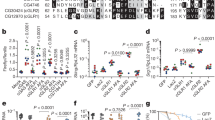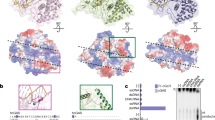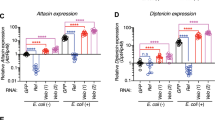Abstract
Drosophila, like other invertebrates and plants, relies mainly on RNA interference for its defense against viruses. In flies, viral infection also triggers the expression of many genes. One of the genes induced, Vago, encodes a 18-kilodalton cysteine-rich polypeptide. Here we provide genetic evidence that the Vago gene product controlled viral load in the fat body after infection with drosophila C virus. Induction of Vago was dependent on the helicase Dicer-2. Dicer-2 belongs to the same DExD/H-box helicase family as do the RIG-I–like receptors, which sense viral infection and mediate interferon induction in mammals. We propose that this family represents an evolutionary conserved set of sensors that detect viral nucleic acids and direct antiviral responses.
This is a preview of subscription content, access via your institution
Access options
Subscribe to this journal
Receive 12 print issues and online access
$209.00 per year
only $17.42 per issue
Buy this article
- Purchase on Springer Link
- Instant access to full article PDF
Prices may be subject to local taxes which are calculated during checkout






Similar content being viewed by others
Change history
15 March 2024
A Correction to this paper has been published: https://doi.org/10.1038/s41590-024-01800-5
References
Beutler, B. et al. Genetic analysis of resistance to viral infection. Nat. Rev. Immunol. 7, 753–766 (2007).
Ding, S.W. & Voinnet, O. Antiviral immunity directed by small RNAs. Cell 130, 413–426 (2007).
Galiana-Arnoux, D., Dostert, C., Schneemann, A., Hoffmann, J.A. & Imler, J.L. Essential function in vivo for Dicer-2 in host defense against RNA viruses in Drosophila. Nat. Immunol. 7, 590–597 (2006).
van Rij, R.P. et al. The RNA silencing endonuclease Argonaute 2 mediates specific antiviral immunity in Drosophila melanogaster. Genes Dev. 20, 2985–2995 (2006).
Wang, X.H. et al. RNA interference directs innate immunity against viruses in adult Drosophila. Science 312, 452–454 (2006).
Zambon, R.A., Vakharia, V.N. & Wu, L.P. RNAi is an antiviral immune response against a dsRNA virus in Drosophila melanogaster. Cell. Microbiol. 8, 880–889 (2006).
Dostert, C. et al. The Jak-STAT signaling pathway is required but not sufficient for the antiviral response of Drosophila. Nat. Immunol. 6, 946–953 (2005).
Kleinjung, J., Romein, J., Lin, K. & Heringa, J. Contact-based sequence alignment. Nucleic Acids Res. 32, 2464–2473 (2004).
Sheldon, T.J., Miguel-Aliaga, I., Gould, A.P., Taylor, W.R. & Conklin, D. A novel family of single VWC-domain proteins in invertebrates. FEBS Lett. 581, 5268–5274 (2007).
Cherry, S. & Perrimon, N. Entry is a rate-limiting step for viral infection in a Drosophila melanogaster model of pathogenesis. Nat. Immunol. 5, 81–87 (2004).
Sabatier, L. et al. Pherokine-2 and -3: Two Drosophila molecules related to pheromone/odor-binding proteins induced by viral and bacterial infections. Eur. J. Biochem. 270, 3398–3407 (2003).
Brand, A.H. & Perrimon, N. Targeted gene expression as a means of altering cell fates and generating dominant phenotypes. Development 118, 401–415 (1993).
Chao, J.A. et al. Dual modes of RNA-silencing suppression by Flock House virus protein B2. Nat. Struct. Mol. Biol. 12, 952–957 (2005).
Li, H., Li, W.X. & Ding, S.W. Induction and suppression of RNA silencing by an animal virus. Science 296, 1319–1321 (2002).
Ji, X. The mechanism of RNase III action: how dicer dices. Curr. Top. Microbiol. Immunol. 320, 99–116 (2008).
Lee, Y.S. et al. Distinct roles for Drosophila Dicer-1 and Dicer-2 in the siRNA/miRNA silencing pathways. Cell 117, 69–81 (2004).
Liu, Q. et al. R2D2, a bridge between the initiation and effector steps of the Drosophila RNAi pathway. Science 301, 1921–1925 (2003).
Okamura, K., Ishizuka, A., Siomi, H. & Siomi, M.C. Distinct roles for Argonaute proteins in small RNA-directed RNA cleavage pathways. Genes Dev. 18, 1655–1666 (2004).
Akasaka, T. et al. The ATP-sensitive potassium (KATP) channel-encoded dSUR gene is required for Drosophila heart function and is regulated by tinman. Proc. Natl. Acad. Sci. USA 103, 11999–12004 (2006).
Reichhart, J.M. et al. Splice-activated UAS hairpin vector gives complete RNAi knockout of single or double target transcripts in Drosophila melanogaster. Genesis 34, 160–164 (2002).
Georgel, P. et al. Drosophila immune deficiency (IMD) is a death domain protein that activates the antibacterial response and can promote apoptosis. Dev. Cell 1, 503–514 (2001).
Tauszig-Delamasure, S., Bilak, H., Capovilla, M., Hoffmann, J.A. & Imler, J.L. Drosophila MyD88 is required for the response to fungal and Gram-positive bacterial infections. Nat. Immunol. 3, 91–97 (2002).
Busse, M.S., Arnold, C.P., Towb, P., Katrivesis, J. & Wasserman, S.A. A κB sequence code for pathway-specific innate immune responses. EMBO J. 26, 3826–3835 (2007).
Obbard, D.J., Jiggins, F.M., Halligan, D.L. & Little, T.J. Natural selection drives extremely rapid evolution in antiviral RNAi genes. Curr. Biol. 16, 580–585 (2006).
Sackton, T.B. et al. Dynamic evolution of the innate immune system in Drosophila. Nat. Genet. 39, 1461–1468 (2007).
Klotman, M.E. & Chang, T.L. Defensins in innate antiviral immunity. Nat. Rev. Immunol. 6, 447–456 (2006).
Smit, A.B. et al. Granularin, a novel molluscan opsonin comprising a single vWF type C domain is up-regulated during parasitation. FASEB J. 18, 845–847 (2004).
Georgel, P. et al. Vesicular stomatitis virus glycoprotein G activates a specific antiviral Toll-like receptor 4-dependent pathway. Virology 362, 304–313 (2007).
Bernstein, E., Caudy, A.A., Hammond, S.M. & Hannon, G.J. Role for a bidentate ribonuclease in the initiation step of RNA interference. Nature 409, 363–366 (2001).
Duchaine, T.F. et al. Functional proteomics reveals the biochemical niche of C. elegans DCR-1 in multiple small-RNA-mediated pathways. Cell 124, 343–354 (2006).
Tabara, H., Yigit, E., Siomi, H. & Mello, C.C. The dsRNA binding protein RDE-4 interacts with RDE-1, DCR-1, and a DExH-box helicase to direct RNAi in C. elegans. Cell 109, 861–871 (2002).
Liu, X., Jiang, F., Kalidas, S., Smith, D. & Liu, Q. Dicer-2 and R2D2 coordinately bind siRNA to promote assembly of the siRISC complexes. RNA 12, 1514–1520 (2006).
Krishna, N.K., Marshall, D. & Schneemann, A. Analysis of RNA packaging in wild-type and mosaic protein capsids of flock house virus using recombinant baculovirus vectors. Virology 305, 10–24 (2003).
Jung, A.C., Criqui, M.C., Rutschmann, S., Hoffmann, J.A. & Ferrandon, D. Microfluorometer assay to measure the expression of β-galactosidase and green fluorescent protein reporter genes in single Drosophila flies. Biotechniques 30, 594–598 600–591 (2001).
Finn, R.D. et al. Pfam: clans, web tools and services. Nucleic Acids Res. 34, D247–D251 (2006).
Hubbard, T.J. et al. Ensembl 2007. Nucleic Acids Res. 35, D610–D617 (2007).
Kasprzyk, A. et al. EnsMart: a generic system for fast and flexible access to biological data. Genome Res. 14, 160–169 (2004).
Stajich, J.E. et al. The Bioperl toolkit: Perl modules for the life sciences. Genome Res. 12, 1611–1618 (2002).
Edgar, R.C. MUSCLE: multiple sequence alignment with high accuracy and high throughput. Nucleic Acids Res. 32, 1792–1797 (2004).
Saitou, N. & Nei, M. The neighbor-joining method: a new method for reconstructing phylogenetic trees. Mol. Biol. Evol. 4, 406–425 (1987).
Thompson, J.D., Gibson, T.J., Plewniak, F., Jeanmougin, F. & Higgins, D.G. The CLUSTAL_X windows interface: flexible strategies for multiple sequence alignment aided by quality analysis tools. Nucleic Acids Res. 25, 4876–4882 (1997).
Guindon, S. & Gascuel, O. A simple, fast, and accurate algorithm to estimate large phylogenies by maximum likelihood. Syst. Biol. 52, 696–704 (2003).
Huson, D.H. et al. Dendroscope: An interactive viewer for large phylogenetic trees. BMC Bioinformatics 8, 460 (2007).
Li, H. et al. TreeFam: a curated database of phylogenetic trees of animal gene families. Nucleic Acids Res. 34, D572–D580 (2006).
Acknowledgements
We thank E. Santiago and S. Ozkan for technical expertise; R. Carthew (Northwestern University), J.-M. Reichhart (Unité Propre de Recherché 9022 Centre National de la Recherche Scientifique) and M. Siomi (University of Tokushima) for fly stocks; A. Schneeman (The Scripps Research Institute) for FHV and anti-FHV; D. Ferrandon for critical reading of the manuscript and comments; and E. Levashina for discussions. Confocal microscopy was done at the Strasbourg Esplanade Cellular Imaging Facility (funded by the Centre National de la Recherche Scientifique, Institut National de la Santé et de la Recherche Médicale, Louis Pasteur University and Alsace Region). Supported by the US National Institutes of Health (PO1 AI070167), Agence Nationale de Recherche Microbiologie-Maladie Emergentes and Centre National de la Recherche Scientifique.
Author information
Authors and Affiliations
Contributions
S.D., N.M., S.M., C.K., D.G.-A., C.D., J.A.H. and J.-L.I. conceived, did and analyzed the experiments; A.B. analyzed the sequences of DExD/H-box helicases; C.A. established and confirmed the identity of transgenic flies expressing FHV B2; and S.D., N.M., J.A.H. and J.-L.I. wrote the manuscript.
Corresponding author
Ethics declarations
Competing interests
The authors declare no competing financial interests.
Supplementary information
Supplementary Text and Figures
Supplementary Figures 1–7 and Supplementary Table 1 (PDF 581 kb)
Rights and permissions
About this article
Cite this article
Deddouche, S., Matt, N., Budd, A. et al. The DExD/H-box helicase Dicer-2 mediates the induction of antiviral activity in drosophila. Nat Immunol 9, 1425–1432 (2008). https://doi.org/10.1038/ni.1664
Received:
Accepted:
Published:
Issue Date:
DOI: https://doi.org/10.1038/ni.1664
This article is cited by
-
The helicase domain of human Dicer prevents RNAi-independent activation of antiviral and inflammatory pathways
The EMBO Journal (2024)
-
Origins and diversification of animal innate immune responses against viral infections
Nature Ecology & Evolution (2023)
-
Innate immune pathways act synergistically to constrain RNA virus evolution in Drosophila melanogaster
Nature Ecology & Evolution (2022)
-
Sensing microbial infections in the Drosophila melanogaster genetic model organism
Immunogenetics (2022)
-
Exploration of binary protein–protein interactions between tick-borne flaviviruses and Ixodes ricinus
Parasites & Vectors (2021)



